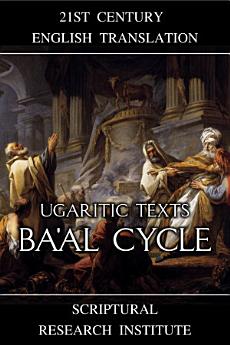Ugaritic Texts: Ba'al Cycle
この電子書籍について
The Ba‘al Cycle is generally divided into several sections, based on the groupings of the tablets that were discovered, however, this series of translations is divided into just two sections, Victorious Ba‘al, and Ba‘al Defeats Mot. These divisions are always subjective. Some translators divide the central section regarding the building of Ba‘al’s Temple on Mount Zaphon from the preceding battle with Yam. Others also separate out the intermediate section involving Ba‘al’s discussion with Anat, however, this series is divided based on the apparent shift in source material between the early section and the later section. The earliest section appears to be a translation from ancient Egyptian and includes Egyptian loanwords, as well as numerous references to the houses of the gods, which seems to be a reference to the system of decans used in Egypt from the Old Kingdom onward, to tell time at night.
The main section of Ba‘al Defeats Mot, appears to have been translated from an old Akkadian text that retold a Hurrian and Hattic story about two gods descending into the underworld. Many Akkadian, Hattic, and Hurrian loanwords are found in the later section, which are mostly missing from the earlier section, as well as the conclusion. The major exception being the messenger Ủgar, who was a Hurrian psychopomp, like the Canaanite Horon, and Greek Charon. As the city of Ugarit was named after him, this name clearly predates the text itself, and so it cannot be used to date the text. Nevertheless, does indicate that the city was originally a Hurrian settlement before becoming Semitic, which helps to explain why the older second section, appears to be a translation of an Akkadian retelling of a Hurrian story. Additionally, Luwian names are found in the second section, which places the origin of the Akkadian source text to sometime between when the Luwians settled in western Anatolia, generally dated to circa 2000 BC, and when the Hittites absorbed the Hattians around 1700 BC. As the text appears to have then been translated into Egyptian, before Ugaritic, it may trace the route the Hyksos took to Egypt, via the Luwian, Hattic, and Hurrian lands.
The first section, Victorious Ba‘al, appears to be a later text, written after 1700 BC, when a massive series of earthquakes destroyed most of the Minoan cities and palaces. The earthquake marks the division between the Old Palace Period and the New Palace Period of Minoan architecture. At the time, there was a significant change in the sky, as the Bull stopped being the asterism that marked the northern vernal equinox, and the Ram replaced him. Unlike the Bull, the Ram was not on the ecliptic, the line in the sky that the sun and planets travel on relative to the earth, but above it. Below the ecliptic, and closer to it, was the Sea Monster, later called Cetus. The battle in the Victorious Ba‘al, was about the storm-god Hadad battling the sea-god Yam, to take over the kingship from the ram-god Attar, and appears to be about the struggle between these two gods to rule the earth after the bull god El had turned over his throne to the ram god Attar. That transition would have happened in circa 1700 BC, and so this text had to be written later than that.








